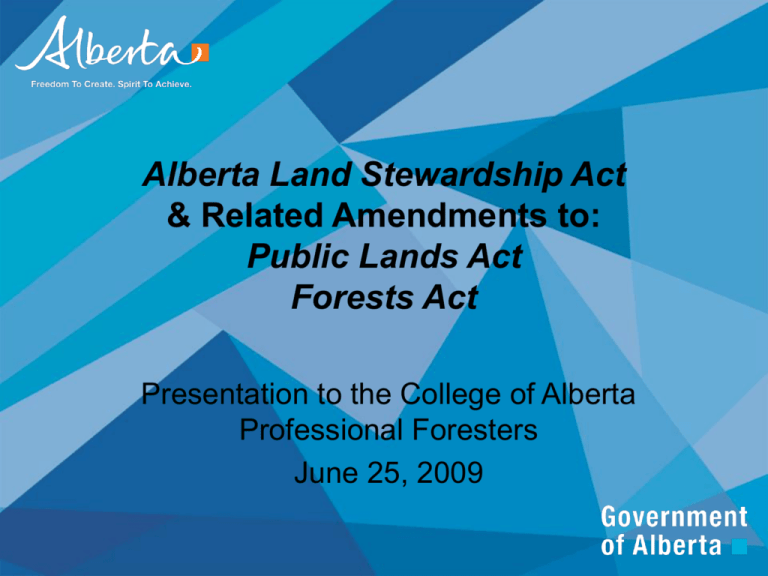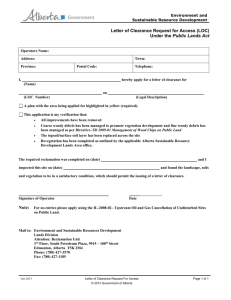Public Lands Act - College of Alberta Professional Foresters
advertisement

Alberta Land Stewardship Act & Related Amendments to: Public Lands Act Forests Act Presentation to the College of Alberta Professional Foresters June 25, 2009 Overview Context For Legislation Alberta Land Stewardship Act Forests Act Amendments Public Lands Act Amendments Status of Regional Plans Impacts of Regional Plans Role of Forestry Professional Context for Legislation Land-Use Framework (LUF) Policy Albertans asked for: Provincial leadership An approach to planning that integrates Alberta’s environmental, economic, and social objectives at the regional level. An approach that encourages stewardship and conservation Alberta Land Stewardship Act Purpose of the Act Means for Government to provide guidance on Economic, Environmental, and Social Objectives Ability to Plan for the needs of Current and Future Generations Enable Sustainable Development and a Cumulative Effects Management approach Part 1 Regional Plans Lieutenant Governor Makes Planning Regions and Plans Elements of a Regional Plan Adopt or Create Sub-Regional Plans Statutory Consents Part 2 Nature, Effect and Compliance Plans are Regulations Plans are Legally Binding Compensation Limited under this Act Compliance Declaration Part 3 Conservation & Stewardship Tools Research and Development Conservation Easements Conservation Directives Conservation Offsets Transfer Of Development Credits Part 4 Regional Planning Process Lieutenant Governor Sets the Process in Motion Regional Advisory Council Approves a Terms of Reference Land-Use Secretariat Not a department Stewardship Commissioner Part 4 Regional Planning Process Landuse Secretariat’s Role in: Regional Plan Development Regional Plan Implementation Information Systems Monitoring and Reporting Part 5 Transitional Provisions & Amendments Conservation Easements transferred from Environmental Protection and Enhancement Act Consequential Amendments Consequential amendments to 26 Acts Align other Acts with regional plans Provides for enforcement of regional plans Forests Act – Consequential Amendments Forests Act – Key Changes Regional Plans take precedence Allows for partial assignments of dispositions Part 3 – Transferred to Public Lands Act Forest Land Use Zones Forest Recreation Areas Forest Recreation Trails Forests Act – Key Changes Section 16 – refers to ‘sustainable forest management’ vs. ‘yield' (outdated) Section 28.1 – can prohibit 3rd parties from selling or buying access to crown timber Section 29 – Reforestation Records Forests Act – Key Changes Enforcement Fine increases Enabling Admin penalty process Scope of ‘Forest Officer’ Expanded Great clarity on investigation, right of entry, seizure process Creative Sentencing Provision Recovery of Economic Benefit Separation of ‘Director’ and ‘Minister’ Forests Act – Key Changes Additional offences: Section 9 – damage of signs, structures Section 10 – cutting, damaging forest growth Section 28.1 – sale or purchase of access to forest land Providing misleading information to forest officer Enables an Appeals Process Public Lands Act – Consequential Amendments Public Lands Act - Amendments Major amendments were necessary: 60 percent of Alberta is Public Land, administered under the Public Lands Act More land management ability is required to implement regional plans Public Lands Act – Key Changes Clarification that Crown is owner of public land Ability to manage cumulative impacts of activity (i.e. access to public land) in accordance with Regional Plans Increased enforcement provisions Public Lands Act – Key Changes Director vs. Minister Establishment of a land stewardship fund Dispositions Cancelled/Suspended/Amended Occupation of Public Land Access to land requires consent Blanket Consent for Disposition Holders Greater ability to manage recreation access to vacant public land Public Lands Act – Key Changes Fines increased New tool - Stop Work Orders Recovery of economic benefit Creative Sentencing New Appeals Section Current Situation Stakeholder sessions held - Concerns: Impact to existing dispositions What does managing rec access mean? Stop Work Orders – need an appeal Timely approvals Current Situation Open Houses held on Bill 36 (ALSA) Seven Weeks of sessions Bill 36 received Royal Assent June 4, 2009 Next Steps Proclamation Regulation Development/Amendment Regional Plan Status Regional Plans Seven Planning Regions Currently two plans are under development Lower Athabasca Regional Plan (LARP) South Saskatchewan Regional Plan (SSRP) Complete all Plans by 2012 Lower Athabasca Regional Plan Regional Advisory Committee Established Terms of Reference nearing Approval Economic Development (Bitumen) Land Conservation Water and Air Thresholds Human Development Vision Statement and Objectives drafted Modelling already underway Complete draft plan – December 2009 South Saskatchewan Regional Plan Regional Advisory Committee appointed Terms of Reference draft stage Population Growth Water State of the Region drafted Modelling input being discussed Final Draft completed by June 2010 Regional Plan Impact Regional Plan Impacts Difficult to Predict Immediate Impacts Depends on the Resolution of the Plan Current Plans At least 4 Levels of Filtering • • • • Cabinet Direction Regional Planning Team Regional Advisory Committee Public, Stakeholder, and First Nations Regional Plan Impacts Cons Potential to affect allocation or approvals However, current message is business as usual Pros Clearer Government Objectives Greater Certainty More Efficient Resource Planning Less Conflict between Industrial users Social License Role Of the Forestry Professional Role Of the Forestry Professional Get Involved Professional Level Regulation Development (Forests Act, Public Lands Act) Regional Advisory Committee Public/Stakeholder Consultations Direct Feedback Role Of the Forestry Professional Individual Level Forestry Professionals have: Broad Base of Ecological Knowledge Planning skills at both the Operational level as well as the long-term 10 - 200 year view Used to Being Specialized Generalist Position ourselves as Facilitators and Mediators Questions?




